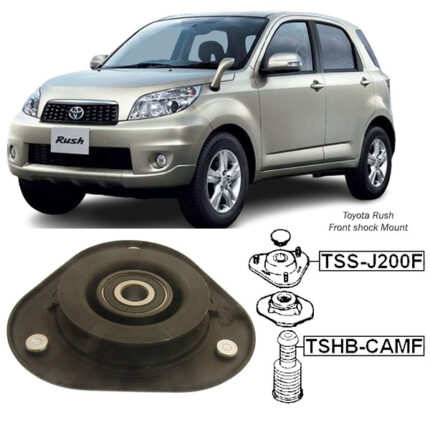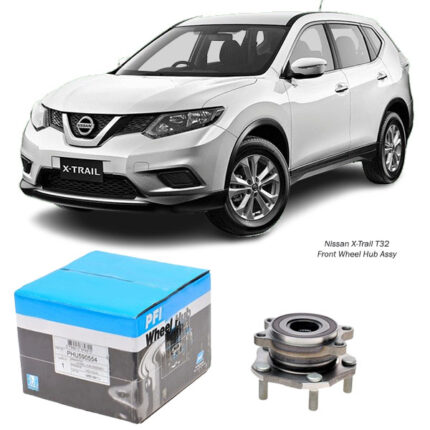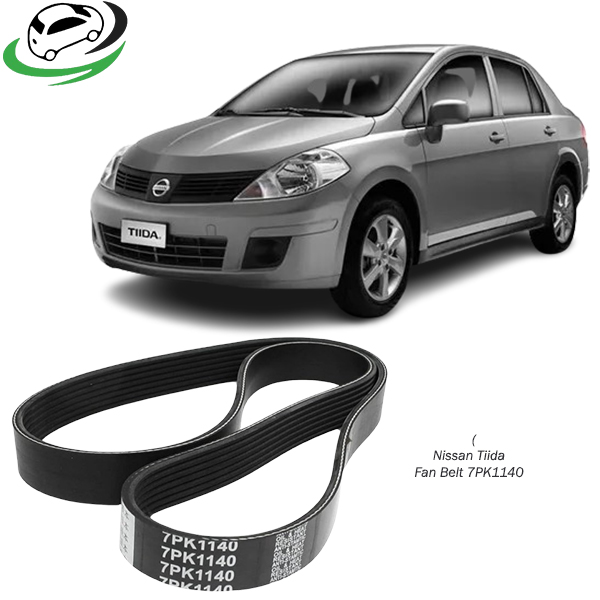-25%
Get Nissan Tiida Fan Belt 7PK1140
The fan belt, commonly known as the serpentine belt or accessory belt, is an integral component of a vehicle’s engine system, ensuring that various essential engine accessories are driven efficiently. In a Nissan Tiida, the fan belt is responsible for powering critical systems like the alternator, air conditioning compressor, power steering pump, and water pump. While it may appear to be a simple rubber loop, the fan belt’s role in the Nissan Tiida is vital for optimal engine performance and smooth vehicle operation.
In this detailed explanation, we will dive into the functions, benefits, signs of wear, replacement procedures, and maintenance tips for the Nissan Tiida fan belt.
Functions of the Nissan Tiida Fan Belt
The fan belt’s main purpose in the Nissan Tiida is to transmit power from the crankshaft to the various engine accessories. As the engine runs, the crankshaft spins, and the fan belt loops around pulleys attached to the accessories. Here are the specific functions the fan belt serves in a Nissan Tiida:
- Powering the Alternator: The alternator generates electricity to charge the car’s battery and power electrical systems, such as lights, radio, and engine control units. The fan belt drives the alternator, ensuring that it continues to produce electricity.
- Driving the Air Conditioning Compressor: For Nissan Tiida models with air conditioning, the fan belt is responsible for operating the air conditioning compressor. The compressor pressurizes refrigerant gas, which enables the cooling of air that’s directed into the cabin.
- Operating the Power Steering Pump: The power steering pump assists in making steering smoother and easier, especially at low speeds. In vehicles equipped with hydraulic power steering, the fan belt powers the pump that provides the necessary hydraulic pressure.
- Running the Water Pump: The water pump ensures that coolant circulates through the engine and radiator, regulating engine temperature. The fan belt drives the water pump, ensuring that the engine doesn’t overheat during operation.
- Engaging the Tensioner and Idler Pulleys: The fan belt works in conjunction with tensioner and idler pulleys, which ensure the belt maintains proper tension and stays aligned. These pulleys reduce friction and wear while keeping the belt tight and moving smoothly over the accessory pulleys.
Benefits of the Nissan Tiida Fan Belt
The fan belt provides several key benefits to your Nissan Tiida:
- Efficient Engine Operation: By transmitting power to essential components such as the alternator and water pump, the fan belt ensures that your engine runs smoothly and efficiently. Without a functional fan belt, these systems wouldn’t be able to operate properly, leading to engine malfunctions.
- Reduced Maintenance Costs: A well-functioning fan belt helps avoid expensive repairs. Since it powers critical components like the water pump and alternator, ensuring the fan belt is in good condition reduces the risk of engine overheating or battery failure, both of which could lead to costly repairs.
- Fuel Efficiency: A properly tensioned fan belt allows accessories to run smoothly without putting extra load on the engine. If the belt is worn or loose, it could result in power loss, requiring the engine to work harder, which may decrease fuel efficiency.
- Longevity of Engine Accessories: The fan belt plays a role in maintaining the longevity of the accessories it powers. A high-quality belt reduces the risk of premature wear or damage to components such as the alternator, water pump, and air conditioning compressor.
- Quieter Engine Performance: A healthy fan belt reduces engine noise by eliminating slippage and providing a smooth transfer of power between components. If your fan belt is worn or misaligned, it could cause squealing or grinding noises, which can be an early sign of failure.
Signs of a Worn or Damaged Fan Belt
Although the fan belt is durable, it is not immune to wear and tear over time. Here are some signs that your Nissan Tiida’s fan belt may need attention:
- Squealing or Chirping Noises: A common sign of a failing fan belt is a high-pitched squeal or chirp, especially during engine startup or when accelerating. This usually indicates that the belt is slipping or has become loose.
- Cracks or Fraying: Regular inspection of the fan belt is crucial. If you notice visible cracks, frayed edges, or splitting along the belt, it’s a clear indication that the belt is wearing out and should be replaced soon.
- Difficulty Steering: If the belt responsible for powering the power steering pump is slipping or broken, you may experience difficulty steering or notice that the steering wheel feels stiff. This can be a dangerous situation and requires immediate attention.
- Overheating Engine: Since the fan belt drives the water pump, a damaged belt could lead to insufficient coolant circulation, causing the engine to overheat. If your engine is overheating frequently, the fan belt could be the culprit.
- Dead Battery: If your alternator isn’t working properly because of a slipping or broken fan belt, your battery may not receive enough charge. This can lead to frequent battery drain or the need for jump starts.
Replacing the Nissan Tiida Fan Belt
Replacing the fan belt on a Nissan Tiida is a relatively straightforward procedure, but it does require some mechanical knowledge and the right tools. Here’s a step-by-step outline of how the process is typically carried out:
- Preparation: Begin by turning off the engine and ensuring that it is completely cool. Disconnect the negative terminal of the battery to prevent any electrical mishaps during the replacement process.
- Locate the Belt Routing Diagram: Before removing the old belt, find the belt routing diagram, typically located under the hood. This diagram shows how the belt loops around the pulleys and will help you install the new belt correctly.
- Release Tension: Use a wrench or a belt tensioner tool to relieve tension from the belt by rotating the tensioner pulley. Once the tension is released, slide the old belt off the pulleys.
- Remove the Old Belt: After releasing the tension, carefully remove the old belt from the pulleys. Inspect the pulleys for any wear or damage before installing the new belt.
- Install the New Belt: Following the belt routing diagram, install the new fan belt by wrapping it around the pulleys. Ensure that the belt is seated correctly in the grooves and that it follows the correct path.
- Tighten the Tensioner: Once the new belt is in place, use the tensioner tool to tighten the belt to the correct tension. The belt should have minimal slack but not be overtightened, as this could cause premature wear.
- Reconnect the Battery: After the belt is installed, reconnect the negative terminal of the battery. Start the engine and inspect the belt to ensure it is running smoothly without any noises or misalignment.
Maintenance Tips for the Nissan Tiida Fan Belt
To ensure the longevity of your Nissan Tiida’s fan belt and avoid unexpected failures, follow these maintenance tips:
- Regular Inspections: Check the fan belt for signs of wear or damage every 6 months or during routine vehicle servicing. Look for cracks, fraying, or misalignment.
- Listen for Noises: Pay attention to any unusual squealing or chirping sounds from the engine, as this could indicate that the belt is slipping or worn.
- Replace When Necessary: If your fan belt shows any signs of deterioration or is nearing the recommended mileage for replacement (typically around 60,000 to 100,000 miles), have it replaced promptly to avoid a breakdown.
- Keep the Belt Clean: Dirt, oil, and grime can cause the fan belt to wear out faster. Regularly clean the engine bay and ensure that no oil or fluid leaks onto the belt.
Conclusion
The fan belt in your Nissan Tiida plays a crucial role in the overall functioning of the vehicle by powering several vital engine components. Regular maintenance and timely replacement of the fan belt will ensure that your vehicle runs efficiently and that you avoid potential engine damage. By paying attention to signs of wear and following the recommended replacement procedures, you can maximize the life of your Nissan Tiida’s fan belt and enjoy a smooth driving experience.
Follow us on Facebook for more parts.



